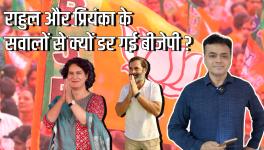No End to Humiliation of Dalits Even After Death
Image for representational use only.
Does anybody still remember the Dalits of Chakwara, a village around 50km from Jaipur in Rajasthan, who had launched a struggle to gain access to the pond in their village? It is more than 18 years since the Dalits, supported by human rights organisations, won that fight for water. Their undertaking had echoes with the historic struggle launched by Dr BR Ambedkar in March 1927 at Chavdar tank at Mahad to assert the equal rights of Dalits to water. It is well known to most people that while animals were allowed to use the water of this tank in present-day Raigad district of the state, the Dalits were not. Anand Teltumbde has described the events of this satyagraha in his book, Mahad: The Making of the First Dalit Revolt, published by Navayana in 2016.
But what happened at Chakwara after the Dalits started using the village pond is hardly known: the upper castes slowly stopped using the water from the pond once the Dalits gained access to it, saying it had become “impure”. Enraged by the assertion of the Dalits and keen to humiliate them for it, they dug up the village sewer and directed the waste water to their own village pond. There is no change in the status quo there.
Around 700km away, in Viramgam near Ahmedabad in Gujarat, a village cemetery used by Dalits was recently flooded with sewer water, a stark reminder that the gap of two decades has not changed the caste scenario in the country. The executioners of this sinister plan in Viramgam were the residents of two housing societies in which the well-off and educated middle classes live. For more than the last six months, the graves of the socially-disadvantaged Vankar, Chamar, Rohit, Dangasia, Shetwa and other communities have been surrounded by dirty water. The district administration did not intervene on behalf of the Dalits despite their repeated complaints. The fact that dignity after death is being denied to marginalised communities did not seem to rouse the administration.
“They were humiliated when they were alive. And now even after they have died, the upper caste people is heaping insult on them by purposefully discharging their solid and liquid waste into our final resting place,” Kirit Rathod, convener of the Dalit Adhikar Manch, told a news outlet earlier this month. This matter has made news now, but it remains to be seen whether the Vijay Rupani government in Gujarat will follow through on the action taken so far against those who deliberately built a channel to divert hazardous waste on to the Dalit’s land.
The Viramgam episode is also just one more instance of what is a widespread phenomenon. The denial of dignity to Dalits even after death is not an exceptional event in India, though many would like to think it is. Plenty of instances occur across the country in which Dalits are denied decent burial grounds. In 2001, a Dalit family from Hooda village in Palanpur block of Banaskantha district, also in Gujarat, buried a two-and-a-half year old deceased child in a community burial ground. Almost immediately, a Patel caste resident of the village exhumed the child’s body with his tractor. The powerful Patels had encroached on some land next to the burial ground and they were “offended” by the burial.
Fifteen years after this incident, the Dalits of Hooda had still not got land for burial allotted to them by the collector and village panchayat. It is very common for Dalits to be denied access to village burial grounds by dominant upper castes, who compel them to use wasteland for the last rites of members of their communities.
A survey done by the Gujarat Rajya Grampanchayat Samajik Nyay Samiti Manch in 2009 found that 657 villages found that 397 had not allotted land for conducting burials to Dalits. In the 260 villages where land had been allotted, 94 had been encroached by the dominant castes and 26 were on low-lying areas that would get waterlogged.
Muslims share a similar predicament, as their graveyards also are encroached into by the dominant classes. Some years ago, the Gujarat High Court asked the state government to post police personnel at Muslim graveyards in Patan, as attempts were on to encroach the land.
In August 2019, at Vaniyambadi taluk of Vellore district in Tamil Nadu, a man’s dead body was seen in a viral video as it was being lowered by his kith and kin over a bridge as part of his last rites. The funeral procession of 46-year-old N Kuppam had been blocked by members of dominant castes, which forced them to use the bridge.
Three months later, another video went viral from Veedhi village in Coimbatore district, Tamil Nadu, showing residents wade through a sewer and dump-yard to reach the crematorium as they were denied access to the crematorium through those lanes in which the upper caste communities live. Around 1,500 Dalit families have repeatedly petitioned the district administration to provide a clear passage to take the dead to cremation ground but to no avail.
Just a few months back, Sabrang India published a report looking at this phenomenon at an all-India level. It says, “With more than half of the lower caste population being landless, the Dalits and people from other backward classes have had to pursue a long standing fight to even live a decent life and attain a decent livelihood. Now with lands not being allocated to them and if allocated, the lands being usurped, along with caste discrimination, the oppressed backward classes have to fight a two-pronged battle for dignity.”
Instances from two different states are quoted in the same report which demonstrate how caste discriminations persist. It cites data from Maharashtra’s ministry for social justice which states that upper castes have usurped 72.13% of the burial grounds earmarked for Dalits in 43,722 villages. Similarly it cites the instance of Punjab, where Dalits are 30% of the population but forced to live on west-facing locations of inhabitations so that the “same breeze” does not blow over non-Dalit households. The Dalits do not just bury their dead in separate cremation grounds. They are also compelled to pray in separate gurudwaras.
Like Maharashtra, where there have been a spate of social reform movements since the mid-19th century, Kerala has also seen multiple social reform movements and agitations including those led by Narayan Guru, Ayyankali and other reformists. No state is perhaps free of some form of reform movement. Yet the irony is that things are not qualitatively different. The journalist Sanu Kummil, in a documentary, “Six Feet Under”, highlights how lack of space in public graveyards has been forcing people to bury their dead on private land, including instances of people having to demolish their homes to bury their dead.
The myriad ways in which a society whose internal dynamics are dictated by norms of “purity” and “pollution” humiliates those whom it considers the “Other” should shock the conscience. Seventy years after becoming a republic and abolishing discrimination based on caste, gender, race and so on, there is no change on the ground.
Perhaps Ambedkar had a premonition of what was to come when the Constitution was written in the name of the people of India. He declared on the floor of the House that India has attained a political democracy’s status—one man, one vote—but the goal of social democracy—one man one value—still eludes us. Ambedkar had imagined a democracy not merely as a form of government but primarily as a mode of associated living. He had envisioned that there would be “an attitude of respect and reverence towards our fellow men”, but that is where India has fallen short.
The author is an independent journalist. The views are personal.
Get the latest reports & analysis with people's perspective on Protests, movements & deep analytical videos, discussions of the current affairs in your Telegram app. Subscribe to NewsClick's Telegram channel & get Real-Time updates on stories, as they get published on our website.
























